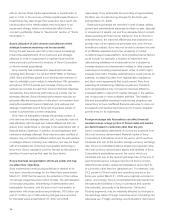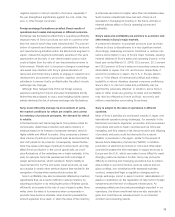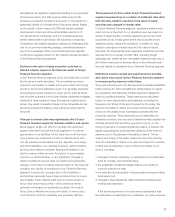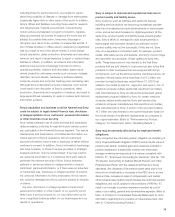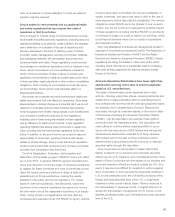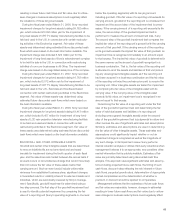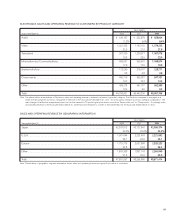Sony 2008 Annual Report Download - page 85
Download and view the complete annual report
Please find page 85 of the 2008 Sony annual report below. You can navigate through the pages in the report by either clicking on the pages listed below, or by using the keyword search tool below to find specific information within the annual report. 83
resulting in lower future cash flows and fair value due to unfore-
seen changes in business assumptions could negatively affect
the valuations of those long-lived assets.
During the fiscal year ended March 31, 2006, Sony recorded
impairment charges for long-lived assets totaling 59,762 million
yen, which included 25,506million yen for the impairment of
long-lived assets of CRT TV display manufacturing facilities to be
held and used in the U.S. in connection with certain restructur-
ing activities in the Electronics segment. Fair value of these
assets was determined using estimated future discounted cash
flows which were based on the best information available. The
impairment charge also included 8,522 million yen for the
impairment of long-lived assets of Sony’s entertainment complex
to be held for sale in the U.S. in connection with restructuring
activities of non-core businesses in All Other. The impairment
charge was based on the negotiated sales price of the complex.
During the fiscal year ended March 31, 2007, Sony recorded
impairment charges for long-lived assets totaling 16,762 million
yen, which included 3,572 million yen for the impairment of
long-lived assets of CRT TV display manufacturing facilities to be
held and used in the U.S., East Asia and Southeast Asia in
connection with certain restructuring activities in the Electronics
segment. Fair value of these assets was determined using
estimated future discounted cash flows which were based on
the best information available.
During the fiscal year ended March 31, 2008, Sony recorded
impairment charges for long-lived assets totaling 19,413 million
yen, which included 6,457 million for impairment of long-lived
assets of LCD rear-projection television manufacturing facilities
to be held and used worldwide in connection with certain
restructuring activities in the Electronics segment. Fair value of
these assets was determined using estimated future discounted
cash flows which were based on the best information available.
■ GOODWILL AND OTHER INTANGIBLE ASSETS
Goodwill and certain other intangible assets that are determined
to have an indefinite life are not amortized and are tested
annually for impairment during the fourth quarter of each fiscal
year, and the assets are also tested between the annual tests if
an event occurs or circumstances change that would more likely
than not reduce the fair value of these assets below their
carrying amount. Such an event would include unfavorable
variances from established business plans, significant changes
in forecasted results or volatility inherent to external markets and
industries, which are periodically reviewed by Sony’s manage-
ment. Specifically, goodwill impairment is determined using a
two-step process. The first step of the goodwill impairment test
is used to identify potential impairment by comparing the fair
value of a reporting unit (Sony’s operating segments or one level
below the operating segments) with its carrying amount,
including goodwill. If the fair value of a reporting unit exceeds its
carrying amount, goodwill of the reporting unit is considered not
impaired and the second step of the impairment test is unnec-
essary. If the carrying amount of a reporting unit exceeds its fair
value, the second step of the goodwill impairment test is
performed to measure the amount of impairment loss, if any.
The second step of the goodwill impairment test compares the
implied fair value of the reporting unit’s goodwill with the carrying
amount of that goodwill. If the carrying amount of the reporting
unit’s goodwill exceeds the implied fair value of that goodwill, an
impairment loss is recognized immediately in an amount equal
to that excess. The implied fair value of goodwill is determined in
the same manner as the amount of goodwill recognized in a
business combination. That is, the fair value of the reporting unit
is allocated to all of the assets and liabilities of that unit (includ-
ing any unrecognized intangible assets) as if the reporting unit
had been acquired in a business combination and the fair value
of the reporting unit was the purchase price paid to acquire the
reporting unit. Other intangible assets are tested for impairment
by comparing the fair value of the intangible asset with its
carrying value. If the carrying value of the intangible asset
exceeds its fair value, an impairment loss is recognized in an
amount equal to that excess.
Determining the fair value of a reporting unit under the first
step of the goodwill impairment test and determining the fair
value of individual assets and liabilities of a reporting unit
(including unrecognized intangible assets) under the second
step of the goodwill impairment test is judgmental in nature and
often involves the use of significant estimates and assumptions.
Similarly, estimates and assumptions are used in determining
the fair value of other intangible assets. These estimates and
assumptions could significantly impact whether or not an
impairment charge is recognized as well as the magnitude of
any such charge. In its impairment review, Sony performs
internal valuation analyses or utilizes third-party valuations when
management believes it to be appropriate, and considers other
market information that is publicly available. Estimates of fair
value are primarily determined using discounted cash flow
analysis. This approach uses significant estimates and assump-
tions including projected future cash flows, the timing of such
cash flows, discount rates reflecting the risk inherent in future
cash flows, perpetual growth rates, determination of appropriate
market comparables and the determination of whether a
premium or discount should be applied to comparables.
Management believes that the estimates of future cash flows
and fair value are reasonable; however, changes in estimates
resulting in lower future cash flows and fair value due to unfore-
seen changes in business assumptions could negatively affect



